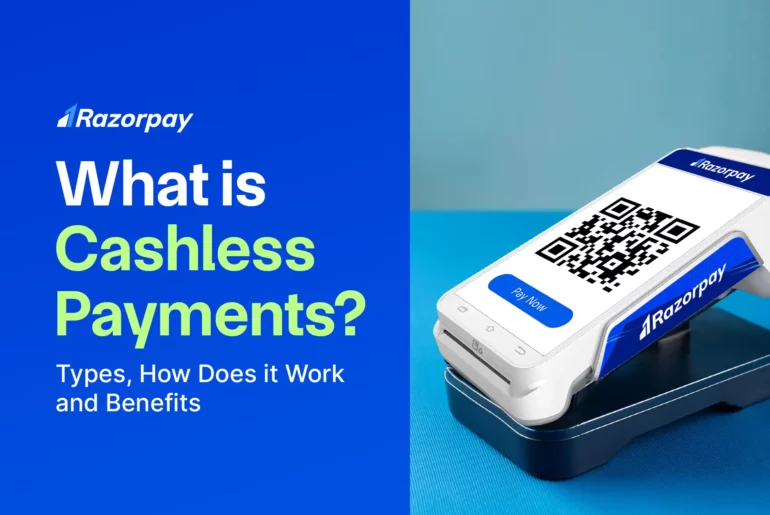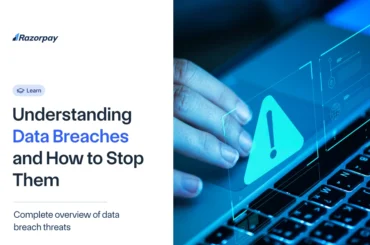Table of Contents
What is Cashless Payment?
Cashless payment is a payment system that is made or accepted without the use of physical cash, instead relying on electronic methods to conduct transactions.
Cashless payment methods include:
- E-wallets
- Mobile Banking Applications
- UPI System
- BHIM App
- Aadhaar Payment App
How Does Cashless Transaction Work?
A cashless transaction involves the electronic transfer of funds between parties. This process relies on a complex network of financial institutions, payment processors, and communication systems.
Here is the Step-by-Step Breakdown
1. Transaction Initiation
Customer Action
The customer initiates a transaction by presenting a payment card (physical or virtual), using a mobile wallet, or entering payment details online.
Data Capture
The point-of-sale (POS) terminal or online payment gateway captures the payment data, including card number, expiration date, CVV, and other relevant information.
2. Authorization Request
Message Generation
The POS or payment gateway generates an authorization request message, containing transaction details.
Message Transmission
The message is sent to the acquirer (the merchant’s bank) through a secure network.
Related Read: Acquirer vs Issuer: Understanding the Key Differences
3. Authorization Processing
Acquirer Processing
The acquirer validates the transaction data and forwards the request to the card issuer (the customer’s bank) through a card network (Visa, Mastercard, etc.).
Issuer Processing
The issuer verifies the cardholder’s account information, available funds, and fraud checks.
Authorization Response: The issuer sends an authorization response to the acquirer, indicating approval or decline.
4. Authorization Response and Transaction Completion
Response Transmission
The acquirer relays the authorization response to the POS or payment gateway.
Transaction Completion
If authorized, the transaction is completed, and a receipt or confirmation is generated.
5. Clearing and Settlement
Batch Processing
Transactions are typically batched and processed at the end of the day.
Funds Transfer
Funds are transferred between the acquirer and issuer through the card network.
Settlement
The acquirer settles the funds with the merchant, minus processing fees.
Related Read: POS Transaction: Meaning, Types, Examples and How it Works?
Types of Cashless Payment Methods
Here are some of the key cashless payment methods:
1. E-wallets
Electronic wallets, or e-wallets, are digital tools that store payment information and enable you to make transactions conveniently through your smartphones or computers.
Examples of E-wallets
An example of e-wallets includes:
- PayPal
- Google Pay
- Apple Pay
All these e-wallets offer a range of features that enhance both convenience and security.
Common Features of E-wallets
- These e-wallets allow you to link your bank accounts or cards and make payments with just a few taps or clicks.
- They often provide additional layers of security, such as two-factor authentication and encryption, to protect your financial information.
- With e-wallets, you can easily make cashless payments online or at physical stores, making transactions faster and hassle-free.
2. Mobile Banking Applications
Mobile banking applications provided by banks and financial institutions allow transactions directly from smartphones.
These apps offer a seamless experience for cashless payments.
You can link your bank accounts and make transfers or payments with just a few taps on your mobile devices.
3. UPI System
The UPI is a real-time payment system in India that enables instant money transfers between bank accounts by using mobile devices.
It provides a convenient and secure platform for individuals to send or receive money without the need for bank account details or IFSC (Indian Financial System Code) codes.
4. BHIM App
The BHIM (Bharat Interface for Money) application (app) is a UPI-based payment application developed by the National Payments Corporation of India (NPCI).
It offers a user-friendly interface and simplifies digital transactions in India.
The BHIM app lets users link multiple bank accounts and make payments using their registered mobile numbers or virtual payment addresses.
5. Aadhaar Payment App
The Aadhar Payment app is a unique digital payment solution that allows transactions using Aadhar numbers linked to your bank accounts without additional authentication methods.
If you do not have a smartphone or debit/credit card, the app offers a USSD (unstructured supplementary service data) based interface that can be accessed through basic feature phones.
It integrates with the Aadhar database, which contains biometric and demographic information of Indians. You can make payments by simply providing your Aadhar number
Overall, the Aadhar Payment App provides a convenient and inclusive way to make digital payments, regardless of the access to smartphones or traditional payment methods.
How To Set Up Cashless Payment Systems for Your Businesses?
Below are the pointers that will help you set up a cashless payment system for your business:
STEP 1: Research and Choose Payment Methods
It is vital to research and choose suitable payment methods. Explore popular options like mobile wallets, UPI, debit/credit cards, and online banking options. Consider your customers’ needs and the ease of use for both you and them.
STEP 2: Select a Payment Processor
Choose a reliable payment processor that offers secure transactions and excellent customer support. Before deciding, compare transaction fees, ease of use, and compatibility with your business.
STEP 3: Upgrade POS System
Ensure that your physical store’s point of sale (POS) system supports cashless payments. If necessary, upgrade or replace the POS system to accept digital payments seamlessly.
STEP 4: Integrate Online Payment Gateways
If you operate online, integrate secure payment gateways into your website or e-commerce platform. This will provide a seamless checkout process for online customers.
STEP 5: Train Your Staff
Train your staff on how to process cashless payments and address customer queries. Make sure they are familiar with the payment methods.
STEP 6: Ensure Security Measures
Implement security measures to protect customer data and your business. Use encryption technology, secure servers, and comply with data protection regulations.
STEP 7: Provide Electronic Receipts
Ensure that customers receive electronic receipts or confirmations for their transactions. This will help them track their purchases and reconcile their accounts.
STEP 8: Monitor Transactions
Monitor cashless transactions regularly for irregularities or fraudulent activities. Address any issues promptly to maintain trust with customers.
STEP 9: Offer Customer Support
Provide clear channels for customer support related to payment issues. Make it easy for customers to reach out and get assistance when needed.
STEP 10: Comply with Regulations
Ensure that your cashless payment systems comply with local and international regulations. Stay updated on any legal changes related to cashless transactions.
How Cashless Payment Systems Benefit Customers?
- Cashless payment systems offer customers convenience and security through digital transactions.
- Cashless payments eliminate the need to carry physical cash.
- One of the critical benefits of cashless transactions is enhanced security. Payment gateways use encryption and authentication methods to protect your financial data, ensuring secure transactions.
- Many merchants provide exclusive deals in the form of discounts and offers for customers who pay digitally, incentivizing the adoption of cashless transactions.
- Additionally, cashless payments provide flexibility to make transactions anytime and anywhere using mobile phones, tablets, or computers.
How Cashless Payment Systems Benefit Businesses?
Below are some of the key advantages of cashless transactions:
1. Convenience in Transactions
Cashless payments provide convenience to businesses by offering various payment methods such as mobile wallets, contactless cards, and online banking services. With these options, you can easily make payments without carrying physical cash.
This simplifies the transaction process and reduces waiting time at checkout counters, improving customer satisfaction. Additionally, digital receipts and transaction history enable you to track your expenses, thereby efficiently managing finances.
2. Security Measures
One of the critical advantages of cashless payment systems is the implementation of robust security measures. These systems utilise encryption protocols and multi-factor authentication to ensure secure and fraud-free transactions.
Secure payment gateways protect sensitive customer information, instilling trust among users.
Furthermore, continuous advancements in cybersecurity technologies protect businesses against evolving threats and cyber-attacks.
3. Discounts and Offers
Cashless transactions offer businesses various discounts and offers. Companies provide cashback rewards, loyalty points, and exclusive deals to encourage digital payments.
These incentives help attract new customers, retain existing ones, and promote specific products or services. Additionally, customer loyalty programs foster repeated purchases and establish long-term relationships between businesses and customers.
Disadvantages of Cashless Payments
Here are some of the key disadvantages of cashless payments:
1. Technology Dependency and Internet Access Challenges
Cashless payments rely heavily on technology, including stable internet connections and electronic devices. Challenges arise when there are connectivity issues or a need for access to the internet, hindering seamless payment processes.
2. Fraud and Hacking Risks in Digital Transactions
Digital transactions are susceptible to fraud and hacking. Cybercriminals use techniques like phishing, malware, and data breaches to exploit vulnerabilities, impacting businesses and customers.
3. Privacy Concerns in Cashless Interactions
Privacy concerns arise in cashless interactions due to data privacy issues and surveillance. Secure handling of customer information becomes crucial to protect sensitive data from unauthorised access.
4. Implementation Challenges for Small Businesses
Small businesses face implementation challenges with cashless payments, including setup costs, staff training, and rapidly evolving technologies that require regular updates and maintenance.
FAQs
1. What is the most popular cashless payment?
The most popular cashless payment method in India is the UPI. It allows users to make instant payments using mobile phones directly from their bank accounts.
2. When did cashless payments start?
Digital payments in India started gaining traction after the 2016 demonetization drives. The government’s push towards a cashless economy led to the rapid adoption of various electronic payment methods.
3. What are the risks of cashless payments?
Some common risks include fraud and security risks, technical glitches, dependency on technology, and privacy concerns, among others.
4. What is the future of cashless payments?
The future of cashless payments in India looks promising. With initiatives like Digital India and increasing smartphone penetration, more people are embracing digital payment.
5. Is cashless payment safer?
Yes, cashless payments are generally safer as they reduce the risk of theft and fraud and offer secure transaction methods through encryption and authentication processes.





